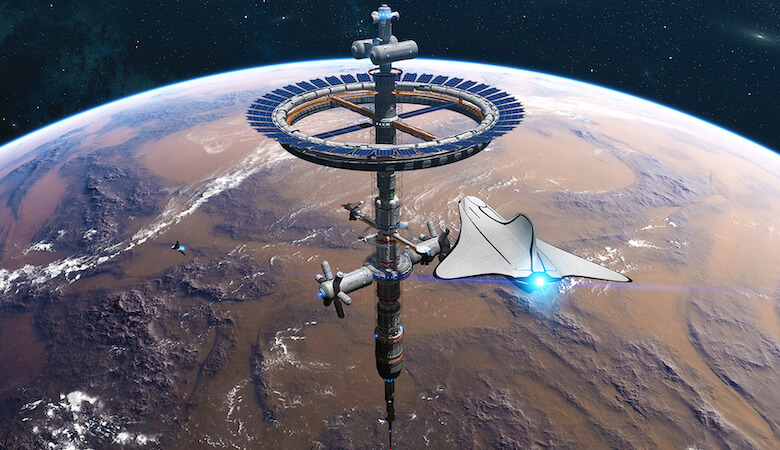Have you ever gazed up at the star-studded sky and wondered, “Can we just climb into space?” Imagine stepping into a futuristic elevator, pressing a button, and being smoothly carried not to another floor, but to outer space. No fiery exhaust required. That’s the idea of a space elevator.
The concept of a space elevator goes back to 1895. Russian scientist Konstantin Tsiolkovsky, inspired by the Eiffel Tower, envisioned a similar structure that would reach all the way into the heavens. Since then, it’s been a popular theme in science fiction.
But is it just a far-fetched dream, or could we actually build a space elevator? Let’s delve into this revolutionary concept and explore whether we can indeed climb our way into space.

What is a Space Elevator?
Imagine you could take an elevator all the way up to space. You’d ride along a giant cable or ribbon, anchored to the ground at the Earth’s equator. This giant tether would stretch all the way up to geostationary orbit, which is about 22,236 miles above Earth.
The cable would be spinning at the same speed as Earth’s rotation, so from the perspective of an Earthling, it would appear to be stationary (geosynchronous orbit). To get up to space, you’d catch a ride on a climbing vehicle that would ascend the cable. It would be like taking any other elevator… except instead of going up a few hundred feet, you’d go up a few thousand miles!

Once you’ve reached geostationary orbit, you could transfer to a spaceship and travel to the moon, Mars, or anywhere else in the solar system. You could launch satellites, staff an orbital factory, or overlook space debris cleanup crews. Or, you could just sit there for a while and savor the view.
Building one would be no easy feat. The cable would need to be extraordinarily strong and lightweight—to the tune of 20 times stronger than any material we’ve mass produced so far.
Despite the engineering challenges, space elevators are extremely appealing for space travel. They seem outlandish, but if we could actually build one, it would solve nearly all the usual problems of getting into space. It would be cheaper, faster, and easier—by several orders of magnitude—than anything we have today.
How Can We Build a Space Elevator?
Building a space elevator would be a monumental undertaking, by any stretch of imagination. However, conceptually, they’re not that complicated. With enough progress in materials science and engineering, building a space elevator wouldn’t be an utterly crazy idea. The design for a space elevator consists of four key components.

Anchor Station
The anchor station firmly secures the elevator to the Earth’s surface. It should be located near the equator to match the Earth’s rotation. This would also allow the elevator to take advantage of Earth’s full rotational speed.
The anchor station must be able to withstand the immense tension of the tether. It must also be able to withstand earthquakes, tsunamis, and high winds. Common anchor station designs include floating sea platforms, mountaintop installations, and deep-sea anchors.
Tether / Cable
The tether is the backbone of the space elevator—the elevator “chute.” It must be incredibly strong and lightweight to withstand gravity, the atmosphere, and space debris. It must also be easy to repair and refurbish, with redundancy to prevent catastrophic failure.
The material requirements for a space elevator tether are demanding and precise. Its material needs to have a high tensile strength-to-weight ratio. If the rope is strong but heavy, its own weight will pull it apart. If the rope is weak but light, it’ll snap in the high atmospheric winds of Earth.
Currently, carbon nanotubes, diamond nanowires, and graphene are leading candidates. Some of these materials are strong and lightweight enough, but we’ve only been able to produce them in small quantities so far.
Counterweight
The counterweight is a massive object placed beyond geostationary orbit. The goal is to make sure the center of mass for the whole system, including the cable, is at geostationary orbit. Basically, we want the elevator to always stay at the same point by revolving around the earth as fast as the earth is turning.
The counterweight’s centrifugal force keeps the tether taut, like a yo-yo. That said, it’s a fine balancing act. If the tether becomes too taut, it could snap. And if the counterweight moves too fast or too slow, it would wrap around the Earth like a belt.
The counterweight could be a captured asteroid, a space station, or a large mass specifically constructed for this purpose. If we go with this last option, it would give a perfect use for all that space scrap we’ve been leaving out there for years.
Climbers
Climbers are the vehicles that traverse the tether, carrying cargo and people between Earth and space. They must have powerful motors, efficient power sources, and plenty of failsafes. Climbers could be powered by solar panels, lasers from the Earth, or a combination of both.
Finally, we’d need a way to perform repairs or refuel along the tether. This could take form as a secondary function of climbers or as standalone base stations along the way up. If we go with the base station route, they could also serve launch points for satellites and spacecraft at different altitudes.
Is a Space Elevator Even Possible?
To build a space elevator, we’d need to solve many technical and engineering challenges. However, the biggest one by far is: What the heck do we make the tether out of?
We must satisfy three requirements:
- High Specific Strength: High specific strength, or strength-to-weight ratio, is crucial for a tether. For a space elevator, it’s estimated to need a specific strength of 100,000 kN·m/kg, or about 1000 times greater than that of steel.
- Durability: The tether must be able to withstand harsh conditions, like radiation, space debris, and the atmosphere. The cable must also be repairable, with enough redundancy to avoid catastrophic failure.
- Manufacturability: We must be able to make enough of it! To satisfy the other two conditions, we’re limited to super advanced materials. But we’d need to make thousands of kilometers of it without any defects.
When considering all three conditions, it’s difficult to find a viable material.
Normal materials simply won’t cut it, right from the first criteria. Steel’s specific strength goes up to 100 kN·m/kg. Titanium’s goes up to about 500 kN·m/kg. Even kevlar only goes up to about 3,200 kN·m/kg.
These are orders of magnitude lower than the estimated 100,000 kN·m/kg needed for a space elevator.
Now, with advanced materials, we start to get somewhere. But the problem with them is that they’re exceedingly hard to produce in large quantities. Let’s take a closer look at a couple of the leading candidates.
Carbon Nanotubes (CNTs)
Carbon nanotubes are hollow cylinders of carbon atoms arranged in a hexagonal lattice. Basically, imagine a straw made entirely of carbon atoms. The width of the straw’s walls are just a tiny fraction of the width of a human hair.
CNTs are one of the strongest materials known, with tensile strengths up to 100 times that of steel at only one-sixth the density. That means they have specific strengths that go up to 120,000 kN·m/kg. That means CNTs clear the threshold for use in a space elevator.
The biggest barrier is that CNTs are still too difficult to make at scale. The longest CNT created so far has stood at a ”whopping” 19.7 inches. That’s approximating 200 million times shorter than what we’d need for a space elevator.

Diamond Nanothreads
Diamond nanowires are another promising material for space elevator cables. They share many of the favorable properties of CNTs. For example, diamond nanowires have specific strengths comparable to CNTs. They’re also even lighter than CNTs, and more resistant to radiation and extreme temperatures.
That said, they might even be more impractical to make than CNTs. Not only are we unable to make them at long lengths, but they’re also too expensive. The cost of diamond nanothreads could flat out prevent them from large-scale use.
To further develop these materials, the real question will be if a market exists to improve upon them. Theoretically, CNTs would become strong enough after a certain point. But so far, there’s been a limited market for them in our current economy.
For real leaps in progress, we’d need a near-term “killer app” for CNTs and other such advanced materials. New quantum computers could also lead to huge breakthroughs in materials science.
Would a Space Elevator Be Worth the Hassle?
Let’s assume we were able to produce CNTs at scale and solve the other engineering challenges involved in building a space elevator. Would it even be worth the hassle for us to make one? Why not just keep using rockets, or maybe something else like space planes?
Surprisingly, the answer is: yes. Despite how absurd the idea sounds at first glance, space elevators could be the ultimate solution to space travel. They fix pretty much all the problems of traditional space launch methods.
For example, space elevators could drastically reduce costs. The cost to send cargo to low-Earth orbit (LEO) today on the best rockets is about $1,500/kg. Researchers estimate that a space elevator would drop that cost down to about $110/kg.
Part of the reason is that a space elevator would use renewable electric power, such as solar power. That means it would also reduce the environmental impact of space launches. Rockets produce large amounts of greenhouse gasses, while a space elevator would not.
Moreover, space elevators could increase safety. Rocket launches are inherently risky because of high speeds, extreme temperatures, and volatile fuels. A malfunction during a launch can be catastrophic. A space elevator, while not without its risks, would likely be much safer by virtue of not needing rapid acceleration or combustion.

Finally, a space elevator could enable more ambitious space missions. It would make it easier to construct large spacecraft, space stations, or even an orbital factory to produce starships. If we ever want to build an interstellar ship, we’d rather build it directly out in space.
Space elevators seem like science fiction, and it would be extremely hard to build one. But the potential benefits would also be immense. A space elevator would revolutionize how we access space, making it safer, more affordable, and more sustainable. So while we won’t be climbing into space any time soon, this is definitely one of those “never say never” dreams.